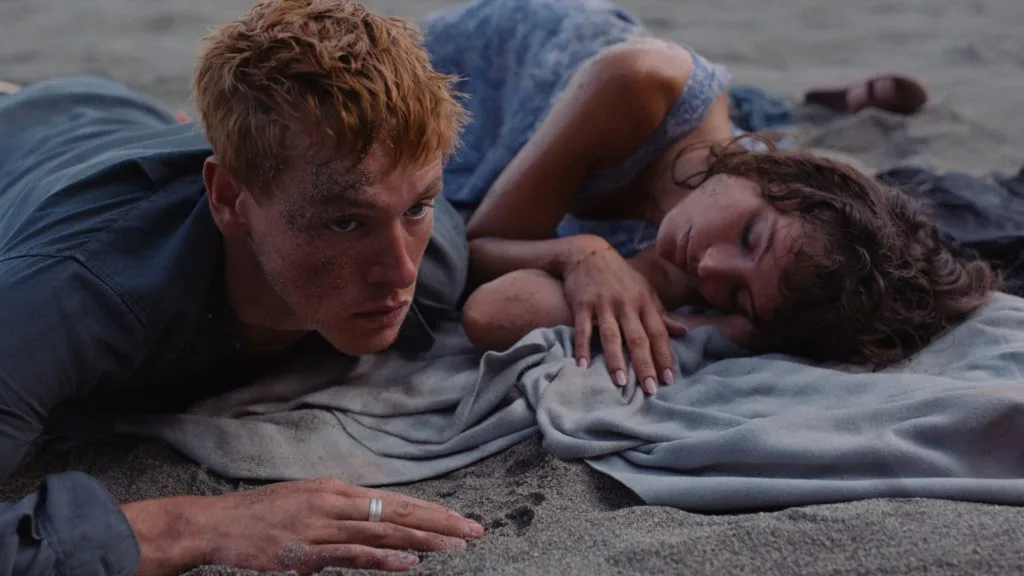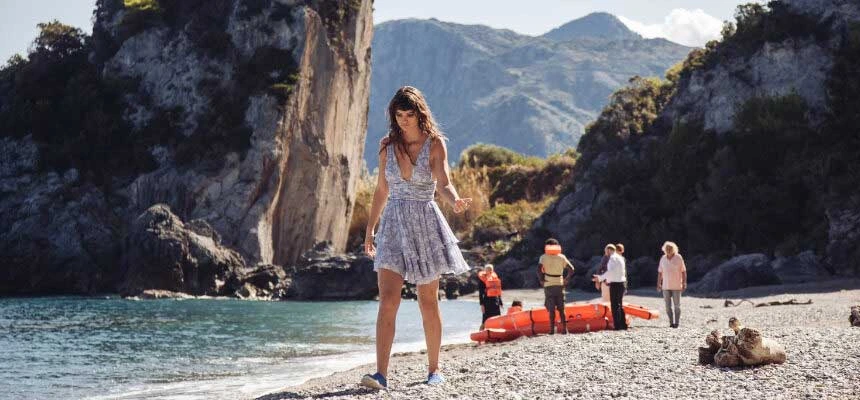Ruben Östlund’s Triangle of Sadness isn’t your typical survival flick or rich-people-go-boating drama. It’s a biting, bizarre, and darkly hilarious takedown of wealth, beauty, and the absurdity of modern power dynamics. Divided into three widely different acts, from ambiguous as it is thought-provoking. If you left the theater wondering what that final rock meant or why Carl was sprinting like a man on fire, you’re not alone. In this deep dive, we unpack the Triangle of Sadness ending, explore what it says about power and survival, and why it still has everyone talking.
⚠️ Spoiler Alert: If you haven’t reached the ending of Triangle of Sadness yet, turn around and go watch the movie and come back to really understand the twists that leave your brain churning and your moral compass spinning.
A Quick Recap: From Fashion Fights to Island Fights
Before we go to the Triangle of Sadness ending, let’s understand the movie’s setup. Triangle of Sadness is divided into three deliciously deranged acts.
- Part 1: We meet Carl and Yaya, a model couple with more abs than honesty. Their relationship is a commentary on influencer culture and financial imbalance, filled with petty arguments about who pays for dinner (and who posts about it).
- Part 2: They board a luxury yacht, surrounded by absurdly wealthy passengers, a Russian oligarch who made a fortune in fertilizer, a sweet old British couple who sold grenades, and a captain who quotes Marx and stays permanently drunk. A literal shitstorm (read: seasickness and sewage overflow) hits during dinner. Then the pirates blow up that boat. As one does.
- Part 3: A ragtag group survives and lands on a deserted island. Turns out, money means squat when you don’t know how to start a fire. Abigail, formerly the toilet manager, becomes queen of the island thanks to her survival skills and uses that power to flip every social and sexual dynamic on its head.
The Triangle of Sadness Ending: What Really Happened?

Now, let’s talk about the Triangle of Sadness ending, where things get truly wild, layered, and painfully ambiguous.
Yaya and Abigail’s Hike to The Truth
After days of island hierarchy and tension, Yaya finally convinces Abigail to explore the other side of the island. The two women trek through the jungle and stumble upon a luxury elevator built into the cliff. Surprise! Turns out, they weren’t lost in the wild; they were just steps away from a luxury resort the whole time.
But instead of feeling relieved, Abigail freezes.
This resort spells the end of her brief reign as a leader. On the island, she’s respected, powerful, and even desired. In the real world? She’s just the help again. And when Yaya, in a well-meaning but tone-deaf moment, offers to help her “become her assistant”, it’s the final insult.
Then Abigail picks up a rock. We never see what she really does with it.
Meanwhile, Carl is Running for Something!
In the final moments, we cut to Carl sprinting wildly through the jungle, scratched and frantic. Is he trying to find Yaya? Is he running toward the resort? Or is he unraveling?
Östlund leaves it to us to decide.
So.. Did Abigail Kill Yaya?
The internet is divided, and honestly? That’s kind of the point.
Yes, She Did (Probably): Many believe Abigail kills Yaya to protect her status. After all, Yaya finding the resort means everyone gets rescued and Abigail returns to a world where she’s invisible. The rock becomes a weapon, one she may be ready to use.
Also, let’s not forget, earlier, we saw Jarmo kill a donkey with a rock in a brutally primal moment. The film has already shown us that survival brings out our basest instincts.
No, She Didn’t (Hopefully): Others argue that Abigail hesitates. She’s angry, sure, but not heartless. Maybe Yaya’s offer is enough to give her pause. Maybe Abigail realized she doesn’t want to become the same kind of person who uses her. The fade to black leaves a sliver of hope that she chooses compassion over violence.
Also, read Another Simple Favor Ending Explained: Twists, Triplets and That Wild Cliffhanger
And Carl’s Running? What’s That About?
We don’t get answers, but we do get theories.
1. He’s Running to Warn Yaya
Maybe Carl figured something out, either about Abigail’s intentions or about the resort, and he’s trying to stop something terrible from happening.
2. He’s Running From the Island
Maybe Carl found out about the resort on his own and is racing to get there before anyone else. Freedom is calling, and he’s not waiting for a group vote.
3. He’s Running From Himself
Carl’s been stripped of his masculinity and agency through Abigail’s transactional relationship. His sprint might be symbolic – a desperate dash away from his own complicity, passivity, or just sheer emotional overload.
Director Ruben Östlund has even said Carl might be trying to get his “male identity back.” Whatever that means.
What the Triangle of Sadness Ending Really Means

Beyond the specifics of rocks and running, here’s what the Triangle of Sadness ending is really poking at:
Power is Contextual
On the yacht, the rich rule. On the island, it’s the cleaners and cooks who take over. Status isn’t static; it’s about who controls the resources. That shift is thrilling to watch and deeply unsettling when reversed again.
Power Corrupts Everyone
Abigail starts out as a sympathetic underdog. But give her a little power, and suddenly she’s manipulating Carl and contemplating murder. It’s not about good vs. evil. It’s about what we become when roles reverse.
Satire That Stings
The title, Triangle of Sadness, refers to the worry lines between your eyebrows, a cosmetic flaw easily erased with Botox. It’s a metaphor for everything the film skewers: the need to mark discomfort, hide inequality, and cover up the ugliness beneath our polished exteriors.
By the time the film ends, the triangle of sadness isn’t just between Carl’s brows. It’s between every character’s choices, regrets, and survival instincts.
Also, read The Backstroke Ending Explained: When Skinny Dips Turn Sinister
Final Thoughts on The Triangle of Sadness Ending
The ending of Triangle of Sadness doesn’t give you closure; it gives you a mirror. What you see in it depends on your own fears, privileges, and moral learnings. Did Abigail bash Yaya’s head with a rock? Did Carl redeem himself? Did anyone?
We may never know. And that’s what makes it so unforgettable.
Because, in the end, Ruben Östlund doesn’t want to answer the question, he wants us to ask ourselves, if you had power, what would you do with it?